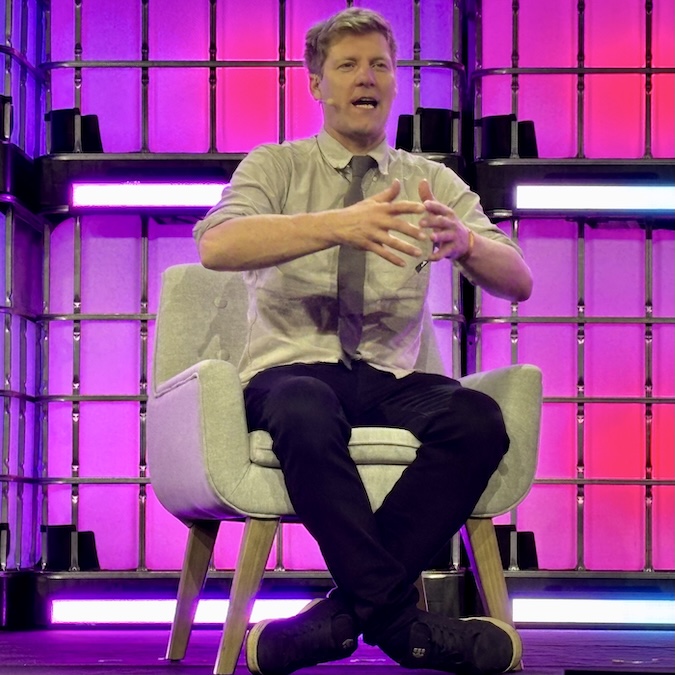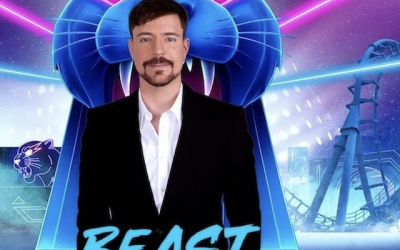At Web Summit 2025 in Lisbon, the British YouTuber Colin Furze – who has spent almost two decades turning madcap engineering projects into viral video gold – spoke to TellyCast host Justin Crosby about tunnels, rockets, and the delicate balance between creativity and control in the digital age.
Now one of the UK’s biggest individual creators, Furze has amassed over 13 million subscribers by blending DIY engineering with pure entertainment. His channel is a hybrid of Top Gear and Brainiac, a place where plumbing skills meet childhood imagination. “People have watched me learn to become an engineer over the past 20 years,” he said, reflecting on the channel’s evolution from homemade stunts to complex builds.
Furze’s journey began in Lincolnshire long before YouTube existed. He was filming BMX tricks and slapstick sketches with friends, inspired by early-2000s VHS culture – “pre-Jackass,” as he calls it. When YouTube arrived, he began uploading short clips cut from his old tapes. His first viral moment involved attaching a flamethrower to a BMX. “It did really well,” he admitted. “But I had to take that one down for obvious reasons.”
His father’s death gave him access to something that would change everything: the family shed. “I wasn’t allowed in there when he was alive,” he said. “That’s where the building really started.” From that moment, Furze began constructing increasingly ambitious contraptions – from magnet shoes to hoverbikes – documenting every triumph and explosion online. A brief spell on Sky One’s Gadget Geeks in 2009 gave him a crash course in television production, but YouTube quickly became the real career. “I used the money from the show to fund a year of projects,” he said. “That was the year YouTube started paying creators. I never went back to plumbing.”
Two decades later, Furze still films, edits, and builds everything himself. It’s a solitary operation, but one that gives him complete freedom. “Being one person can be a blessing and a curse,” he said. His most recent project — a sprawling underground tunnel connecting his house, workshop and garden bunker – took years to complete. “I had to worry about the path falling in, the house falling in, everything falling in,” he said. The tunnel saga became a ten-part YouTube event, drawing millions of views and a devoted following waiting months between instalments. “Every comment was, ‘Never mind this, what’s happening with the tunnel?’” he laughed.
Furze’s output has always straddled engineering and entertainment. He makes no claim to scientific rigour – the builds exist to thrill. He designs videos with families in mind, conscious that parents and children often watch together. “I always think of a parent sat there with their child,” he said. “No swearing, nothing you can’t explain away with, ‘He’s just talking about his dog.’” The result is a uniquely wide audience. Though his analytics say 96 per cent male, Furze insists the real mix is far broader. “At events, everyone comes up – all ages, genders, all sorts of people. You can’t define a Colin Furze viewer.”
Like many creators, his audience is global, though the mix shifts depending on the project. “If I do bicycle stuff, India, Vietnam and the Netherlands all rise up,” he said. “Different projects appeal to different countries.”
Asked when he realised YouTube could become a full-time career, Furze pointed to two early moments. First, the “caravan crash” – an absurd sketch involving a mobile burger van and a costume borrowed from his local football team – which convinced him his homemade chaos could entertain a wide audience. Second, the Wall of Death – a circular motorcycle stunt built from scrap pallets – which YouTube itself promoted on its homepage. “That was my ground zero,” he said. “That’s when my YouTube mind started.”
Furze’s relationship with traditional television has been limited. “When there’s a production company involved, I lose my nimbleness,” he said. “They put it through the health and safety filter and what comes out isn’t quite a Colin Furze thing.” For him, broadcast’s rules of caution clash with YouTube’s creative immediacy. “I understand why – but my way of working is different.”
He remains loyal to YouTube, despite maintaining accounts on TikTok, Instagram and Facebook. “YouTube’s model has always been the best,” he said. “And the biggest change now is that most people are watching on smart TVs. Around 70 per cent of my audience are on television screens.” That shift, he believes, has transformed production standards for creators. “You have to shoot in 4K now, with good sound. People are watching in their living rooms – it has to look right.”
Revenue still comes primarily from YouTube ad income, but brand partnerships now make up a growing share. Furze integrates sponsors into his builds with humour and inventiveness. “The first time I saw a mid-roll advert I thought, ‘This is awful,’” he said. “So I make them fun – something weird that keeps people watching.” Repeat sponsors, he says, prove the approach works.
His community also plays a direct role in shaping ideas. Comments often inspire experiments, from a fan suggesting “hydroforming” metal with a pressure washer to the audience voting on the names of his inventions. “If you’ve got a problem,” he said, “ask the internet. You’re crowdsourcing all those minds.”
After more than 450 videos, Furze still works out of his back garden in Stamford, Lincolnshire. He’s quick to reassure curious neighbours that their houses won’t collapse into his tunnel. “We’re on rock,” he said. “It’s pretty solid ground.” The next phase of the project, he revealed, will be a fully functioning underground garage lift that raises his car to the surface and turns it around – a James Bond-style finale to a decade of subterranean engineering.
He smiled when asked what comes next. “Once that’s finished, that’s it,” he said. “No more limestone. I don’t want to see another piece of it again.”
For Colin Furze, though, “finished” rarely means done. On YouTube, there’s always another invention – and another hole to dig.





